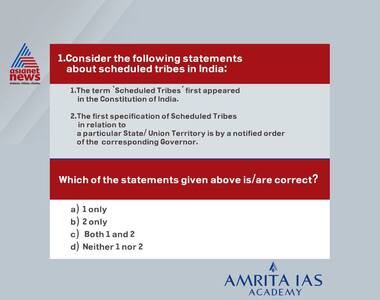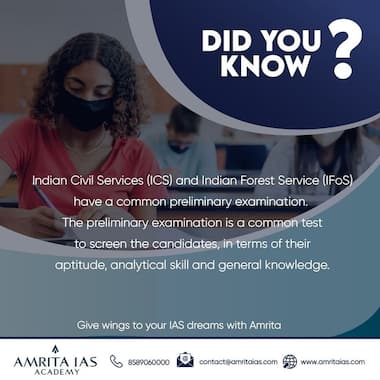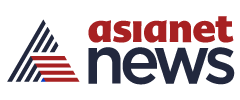Civil Service Exam: റിവേഴ്സ് ഓസ്മോസിസ് സാങ്കേതിക വിദ്യയെക്കുറിച്ച് എന്തറിയാം ?
ഇന്ത്യന് ബ്യൂറോക്രസിയുടെ ഏറ്റവും ഉയര്ന്ന പദവികളിലേക്കുള്ള പരീക്ഷയായ സിവില് സര്വ്വീസ് പരീക്ഷയ്ക്കായി ഏഷ്യാനെറ്റ് ഓണ്ലൈനും അമൃത ഐഎഎസ് അക്കാദമിയും ചേര്ന്നൊരുക്കുന്ന ചോദ്യമാതൃകയുടെ ഏഴുപത്തിരണ്ടാം ഭാഗം.

Answer (a)
Statement 1 is correct. The term ‘Scheduled Tribes’ first appeared in the Constitution of India.
o Article 366 (25) of the Constitution of India defined scheduled tribes as “such tribes or tribal communities or parts of or groups within such tribes or tribal communities as are deemed under Article 342 to be Scheduled Tribes for the purposes of this constitution”.
o Article 342 prescribes the procedure to be followed in the matter of specification of scheduled tribes.
Statement 2 is not correct. The first specification of Scheduled Tribes in relation to a particular State/ Union Territory is by a notified order of the President, after consultation with the State governments concerned. These orders can be modified subsequently only through an Act of Parliament.

Answer (c)
• Each province and each Indian State or group of States were allotted the total number of seats proportional to their respective populations roughly in the ratio of one to a million. As a result, the provinces were to elect 292 members while the princely States were allotted a minimum of 93 seats.
• The seats in each province had been divided amongst Muslims, Sikhs and general in accordance to their population. Members of each community elected their representatives by the method of proportional representation on the basis of a single transferable vote.
• The method of deciding the representatives of the princely states was to be decided by consultations.
• There was no role played by the Muslim League in the constituent assembly as it had boycotted this meeting citing their demand for partition.
• Objective Resolution enshrined the aspirations and values of the constitution-makers. Under this, the people of India were guaranteed social, economic, and political justice, equality, and fundamental freedoms. This resolution was unanimously adopted on 22 January 1947 and the Preamble to the Constitution is based on it.
Answer (c)
Statement 1 is correct. The proposed solution consists of two components- Pillar One which is about reallocation of an additional share of profit to the market jurisdictions and pillar two consisting of minimum tax and subject to tax rules. This two-pillar plan, Inclusive framework tax deal on Base Erosion and Profit Shifting (BEPS)- seeks to reform international tax rules and ensure that multinational enterprises pay their fair share wherever they operate.
Statement 2 is correct. India has joined the G20–OECD inclusive framework deal that seeks to reform international tax rules and ensure that multinational enterprises pay their fair share wherever they operate. 130 countries and jurisdictions, representing more than 90% of global GDP, have signed the deal. India is in favor of a consensus solution that is simple to implement and simple to comply with.
Answer (a)
• In India, the first official rural and urban poverty lines at the national level were introduced in 1979 by Y. K. Alagh Committee and official poverty counts began for the first time. Later, in 1993, D. T. Lakdawala Committee extended these poverty lines to states and over time allowed official poverty counts over time and in the states.
• In 2005, recognizing that the rural poverty line was too low, the government appointed the Tendulkar committee to take a fresh look at the poverty lines. Reporting in 2009, the Tendulkar Committee revised upward the rural poverty line. Continued media criticisms led the government to appoint the Rangarajan Committee in 2012.
• Reporting in June 2014, the Rangarajan Committee recommended raising further both the rural and urban poverty lines. The decision is yet to be taken on the Rangarajan Committee recommendations.
Answer (d)
Lord William Bentinck (1828-1835): During his tenure as Governor-General following were the various events that took place:
o Abolition of sati and other cruel rites (1829).
o Suppression of thug (1830).
o Charter Act of 1833.
o Resolution of 1835, and educational reforms and introduction of English as the official language.
o Annexation of Mysore (1831), Coorg (1834), and Central Cachar (1834).
o Treaty of 'perpetual friendship with Ranjeet Singh.
o Abolished the provincial court of appeal and circuit.
Answer (a)
• PM Kisan is a Central Sector Scheme with 100% funding from the Government of India. It has become operational from 1.12.2018.
• Under the scheme income support of 6,000/- per year in three equal installments will be provided to small and marginal farmer families having combined landholding/ownership of up to 2 hectares.
• In the revised guidelines, in 2019, all farmer families irrespective of their landholding size brought under the scheme.
Answer (d)
Zoji La
o High mountain pass located in the Kargil district of UT of J&K
o Links Leh with Srinagar
Lipulekh
o International pass between India, China, and Nepal
o High altitude mountain pass located in Western Himalayas
Nathu La
o Connects Sikkim with Tibet
o Important trade route between India and China
Jelep La
o Connects Sikkim with Tibet
o Passes via Chumbi valley
Answer (b)
Statement 1 is correct. Reverse Osmosis is a technology that is used to remove a large majority of contaminants from water by pushing the water under pressure through a semi-permeable membrane. Reverse Osmosis is very effective in treating brackish, surface, and groundwater for both large and small flow applications.
Statement 2 is not correct. The initial cost required is huge to set up a RO plant. On average, it costs about ₹900 crores to build a 100 MLD plant. Also, it will take long time that is about five years for a plant to be set up.
Statement 3 is not correct. According to the NGT (national green tribunal), RO purifiers lead to the wastage of almost 70-80 percent of water during the purification process. The National Green Tribunal (NGT) asked MoEF to frame rules for the use of RO filters and also banned the use of RO purifiers in locations where total dissolved solids (TDS) are low.
Answer (d)
• Self-driving cars like, Tesla are possible only with the support of artificial intelligence. Which have the ability to perform cognitive tasks like thinking, perceiving, learning, problem-solving, and decision making. Apart from it, in the transport sector, AI could improve the safety, speed, and efficiency of rail traffic by minimizing wheel friction, maximizing speed, and enabling autonomous driving.
• Artificial intelligence against Covid-19 – In the case of Covid-19, AI has been used in thermal imaging in airports and elsewhere. In medicine, it can help recognize infection from computerized tomography lung scans. It has also been used to provide data to track the spread of the disease.
• Fighting disinformation – Certain AI applications can detect fake news and disinformation by mining social media information, looking for words that are sensational or alarming, and identifying which online sources are deemed authoritative
• Smart and energy-efficient homes, cities, and infrastructure – Smart thermostats learn from our behavior to save energy, while developers of smart cities hope to regulate traffic to improve connectivity and reduce traffic jams.
• Online shopping and advertising – Artificial intelligence is widely used to provide personalized recommendations to people, based for example on their previous searches and purchases or other online behavior. AI is hugely important in commerce: optimizing products, planning inventory, logistics etc. Search engines learn from the vast input of data, provided by their users to provide relevant search results
Answer (a)
Statement 1 is correct. The rising pollution levels of the 1960s and 1970s prompted having laws and regulations in place for environmental concerns. These concerns were addressed at the 1972 United Nations Conference on Human Environment (also known as the Stockholm Conference). The Conference led to the adoption of the Stockholm Declaration (Declaration on the Human Environment) and the formation of a management body for these concerns, which was later called the United Nations Environment Programme (UNEP). Headquartered in Nairobi, the UNEP is headed by an Executive Director.
Statement 2 iscorrect. Emissions Gap Report 2020 is published annually by the United Nations Environment Programme (UNEP). This report measures the gap between anticipated emissions and levels consistent with the Paris Agreement goals of limiting global warming this century to well below 2°C and pursuing 1.5°C.
Statement 3 is not correct. UNDP is based on the merging of the United Nations Expanded Programme of Technical Assistance, created in 1949, and the United Nations Special Fund, established in 1958.The UNDP was established in 1965 by the General Assembly of the United Nations.
Statement 4 is not correct. UNDP does not provide financial assistance to individuals (including students seeking scholarships for their studies), companies or private groups. UNDP works in collaboration with governments on development programmes and projects.
















